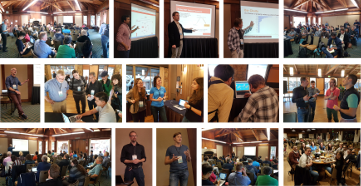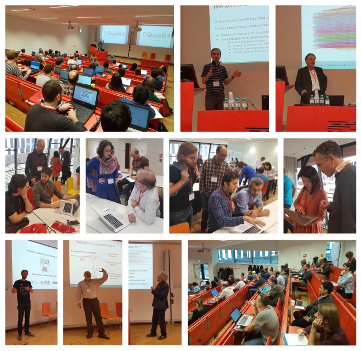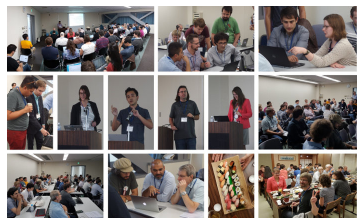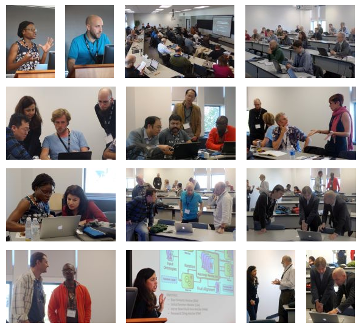Visualization and Interaction for Ontologies and Linked Data
5th International Workshop co-located with ISWC 2020, November 2nd 2020, Virtual Conference

Motivation and Objectives
A picture is worth a thousand words, we often say, yet many areas are in demand of sophisticated visualization techniques, and the Semantic Web is not an exception. The size and complexity of ontologies and Linked Data in the Semantic Web constantly grows and the diverse backgrounds of the users and application areas multiply at the same time. Providing users with visual representations and intuitive interaction techniques can significantly aid the exploration and understanding of the domains and knowledge represented by ontologies and Linked Data.
Ontology visualization is not a new topic and a number of approaches have become available in recent years, with some being already well-established, particularly in the field of ontology modeling. In other areas of ontology engineering, such as ontology alignment and debugging, although several tools have been developed, few provide a graphical user interface, not to mention navigational aids or comprehensive visualization and interaction techniques.
In the presence of a huge network of interconnected resources, one of the challenges faced by the Linked Data community is the visualization of multidimensional datasets to provide for efficient overview, exploration and querying tasks, to mention just a few. With the focus shifting from a Web of Documents to a Web of Data, changes in the interaction paradigms are in demand as well. Novel approaches also need to take into consideration the technological challenges and opportunities given by new interaction contexts, ranging from mobile, touch, and gesture interaction to visualizations on large displays, and encompassing highly responsive web applications.
There is no one-size-fits-all solution but different use cases demand different visualization and interaction techniques. Ultimately, providing better user interfaces, visual representations and interaction techniques will foster user engagement and likely lead to higher quality results in different applications employing ontologies and proliferate the consumption of Linked Data.
Program
The workshop will take place online on November 2nd 2pm-5:30pm central european time
(link provided by ISWC to registered participants).
14:00 - 14:15 Opening
14:15 - 15:15 Session I
by Federico Desimoni, Nikos Bikakis, Laura Po and George Papastefanatos
14:35 - 14:55 User-Centered Design for Knowledge Imbalance Analysis: A Case Study of ProWD
by Nadyah Hani Ramadhana, Fariz Darari, Panca O. Hadi Putra, Werner Nutt, Simon Razniewski and Refo Ilmiya Akbar
14:55 - 15:15 Towards Designing a Tool For Understanding Proofs in Ontologies through Combined Node-Link Diagrams
by Tamara Flemisch, Ricardo Langner, Christian Alrabbaa and Raimund Dachselt
15:45 - 17:10 Session II
by Damien Graux, Fabrizio Orlandi, Brian Lynch, Isobel Mahon, Odhran Mullen, Alex Mahon, Flora Molnar and Lexes Mantiquilla
16:05 - 16:25 ChImp: Visualizing Ontology Changes and their Impact in Protégé
by Romana Pernisch, Mirko Serbak, Daniele Dell'Aglio and Abraham Bernstein
16:25 - 16:45 LogVis: Graph-Assisted Visual Analysis of Equipment Logs
by Tugba Kulahcioglu, Dmitriy Fradkin, Ayse Parlak and Alexander Belkov
16:45 - 17:05 The Semantic Combining for Exploration of Environmental and Disease data dashboard for Clinician Researchers
by Albert Navarro-Gallinad, Alan Meehan and Declan O'Sullivan
17:30 Closing
Proceedings
The workshop proceedings are published as CEUR-WS volume 2778.
V. Ivanova, P. Lambrix, C. Pesquita, V. Wiens: Proceedings of the Fifth International Workshop on Visualization and Interaction for Ontologies and Linked Data (VOILA '20), Virtual Workshop. CEUR Workshop Proceedings, vol. 2778, CEUR-WS.org, 2020.
Topics of Interest
Topics, subjects, and contexts of interest include (but are not limited to):
- Topics:
- visualizations
- user interfaces
- visual analytics
- requirements analysis
- case studies
- user evaluations
- cognitive aspects
- Subjects:
- ontologies
- linked data
- knowledge graphs
- ontology engineering
- Contexts:
- classical interaction contexts (desktop, keyboard, mouse, etc.)
- modern interaction contexts (mobile, touch, gesture, speech, etc.)
- special settings (large, high-resolution, and multiple displays, etc.)
- specific user groups and needs (people with disabilities, domain experts, etc.)
Special Theme 2020
This year, we plan to have a special session on Visualization for Semantic Explainability, a budding field where ontologies and knowledge graphs are explored to provide or enhance the explainability of machine learning models. Submissions addressing this special theme could include one or more of the following:
- visualization techniques for semantic explainability
- user studies on explainability with knowledge graphs and ontologies
- cognitive aspects and requirements of semantic explainability
Submission Guidelines
Paper submission and reviewing for this workshop are organized via EasyChair. The papers should be written in English, following the Springer LNCS format, and be submitted in either PDF or in HTML on or before August 19th, 2020 (extended). Abstracts are due on or before August 10th, 2020 (extended). All deadlines are midnight Hawaii time.
For details on the PDF submission format, see Springer's LNCS guidelines. For HTML submission guidance, see the HTML submission guide of ISWC 2020.
The following types of contributions are welcome. The recommended page length is given in brackets. There is no strict page limit but the length of a paper should be commensurate with its contribution.
- Full research papers (8-12 pages);
- Experience papers (8-12 pages);
- Position papers (6-8 pages);
- Short research papers (4-6 pages);
- System papers (4-6 pages).
It is recommended to include a (persistent) URI to a working implementation or an (annotated) screencast for submissions presenting interactive visualizations, user interfaces, tools, etc.
Accepted papers will be published as a volume in the CEUR Workshop Proceedings series, as in previous years.
For details concerning the conference and/or workshop registration, please refer to the ISWC registration page.
Organizers
Patrick Lambrix, Linköping University, Sweden
Catia Pesquita, University of Lisbon, Portugal
Vitalis Wiens, L3S, TIB, & Leibniz University Hanover, Germany
Programme Committee
Anastasia Dimou, Ghent University
Roberto García, Universitat de Lleida
Alain Giboin, INRIA
Anika Groß, University of Leipzig, Germany
Ali Hasnain, Insight Centre for Data Analytics, Ireland
Emmanuel Pietriga, INRIA
Harald Sack, FIZ Karlsruhe, Leibniz Institute for Information Infrastructure & KIT Karlsruhe
Daniel Schwabe, Dept. of Informatics, PUC-Rio
Kamran Sedig, University of Western Ontario
Ahmet Soylu, Norwegian University of Science and Technology
Markel Vigo, The University of Manchester
Kārlis Čerāns, University of Latvia, Latvia
Important Dates
Abstract: August 10, 2020 (extended)Submission: August 19, 2020 (extended)Notification:September 30, 2020 (extended)Camera-ready: October 9, 2020 (extended)- Workshop: November 2nd, 2020





